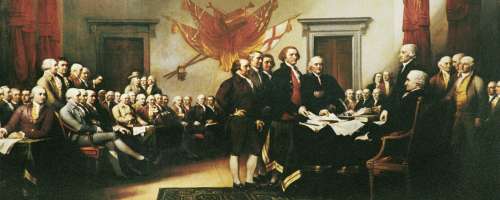 |
Patriot Resource Index
 American Revolution Index
American Revolution Index
 Surveys and Lists
Surveys and Lists
Military Campaigns
Reference Lists
Surveys By Year
-:1763-68: Tensions Rise
-:1768-74: Prelude to War
-:1775: War Begins
-:1776: Independence
-:1777: War Continues
-:1778: War Continues
-:1779: War Continues
-:1780: War Moves South
Timeline: 1780
Battles: 1775-1781
-:1781: Victory
-:1782-1789/Bibliography
 American Revolution Index
American Revolution Index
 Battles
Battles
 Documents
Documents
 Events
Events
 Landmarks & Places
Landmarks & Places
 People: The Patriots
People: The Patriots
 People: Continental Army
People: Continental Army
 People: British Army
People: British Army
 Timelines
Timelines
 Books
Books
 Multimedia
Multimedia
 Links & Other Resources
Links & Other Resources
Search the Site
Site Map
Contact Us
PatriotResource.com:
Main Index
Film Index
Film: Gladiator
Film: National Treasure
Film: The Patriot
Film: Tombstone
Films: General
Films: Fantasy
Films: SciFi
History: 1775-1781
History: September 11th
Lord of the Rings
NORAM Road Trips
OtherWorld: Index
TV Series: Index
TV: Battlestar Galactica
TV: Caprica
TV: Deadliest Catch
TV: Lost
TV Series: Action
TV Series: Animated
TV: BBC Presentations
TV Series: Comedy
TV Series: Drama
TV: Fantasy/SciFi
TV Series: Western
TV Series: Reviews
Military Campaigns
Reference Lists
Surveys By Year
-:1763-68: Tensions Rise
-:1768-74: Prelude to War
-:1775: War Begins
-:1776: Independence
-:1777: War Continues
-:1778: War Continues
-:1779: War Continues
-:1780: War Moves South
Timeline: 1780
Battles: 1775-1781
-:1781: Victory
-:1782-1789/Bibliography
Site Map
Contact Us
Main Index
Film Index
Film: Gladiator
Film: National Treasure
Film: The Patriot
Film: Tombstone
Films: General
Films: Fantasy
Films: SciFi
History: 1775-1781
History: September 11th
Lord of the Rings
NORAM Road Trips
OtherWorld: Index
TV Series: Index
TV: Battlestar Galactica
TV: Caprica
TV: Deadliest Catch
TV: Lost
TV Series: Action
TV Series: Animated
TV: BBC Presentations
TV Series: Comedy
TV Series: Drama
TV: Fantasy/SciFi
TV Series: Western
TV Series: Reviews

General Clinton began the Siege of Charleston on April 13. After a month, Maj. General Benjamin Lincoln surrendered on May 12. On June 5, Clinton left to return to New York and charged his second-in-command, Lt. General Charles Cornwallis to subjugate the South, without compromising British control of Savannah and Charleston. Cornwallis immediately set up a semicircle of garrisons across South Carolina.
Meanwhile, Maj. General Horatio Gates was chosen to replace General Lincoln as Southern Commander and immediately set out to confront General Cornwallis. On August 16, 1780 at the Battle of Camden, South Carolina, Cornwallis routed Gates. The militia had quickly fled the field, leaving the Continental regulars led by Baron de Kalb outnumbered. Gates himself fled north for miles.
In the North, treason had shaken the Patriot cause. Brig. General Benedict Arnold had lobbied for command of West Point, which guarded the Hudson River north of New York City. General George Washington named him to the post on August 3. Arnold began to weaken the post's defenses to make it easier to fall to the British. On September 22, Arnold's British contact Major John André was captured and Arnold's treacherous plan was revealed. Hee himself was able to escape to the British.
General Cornwallis now controlled most of South Carolina, although partisans Thomas Sumter and Francis Marion continued to harass his supply lines and outposts. Cornwallis' attempt to invade North Carolina was foiled when his left flanking force under Major Patrick Ferguson was wiped out at the Battle of King's Mountain, South Carolina. Cornwallis then retreated back south to Winnsboro, South Carolina, and quartered for the winter.
On October 17, Congress replaced General Gates. On December 3, Maj. General Nathanael Greene arrived at Deep River, North Carolina and took command from General Gates. He spent the next month, restoring discipline and reequipping his army, which was now reduced to a rabble. On December 21, 600 men under Brig. General Daniel Morgan were split from Greene's main army.


